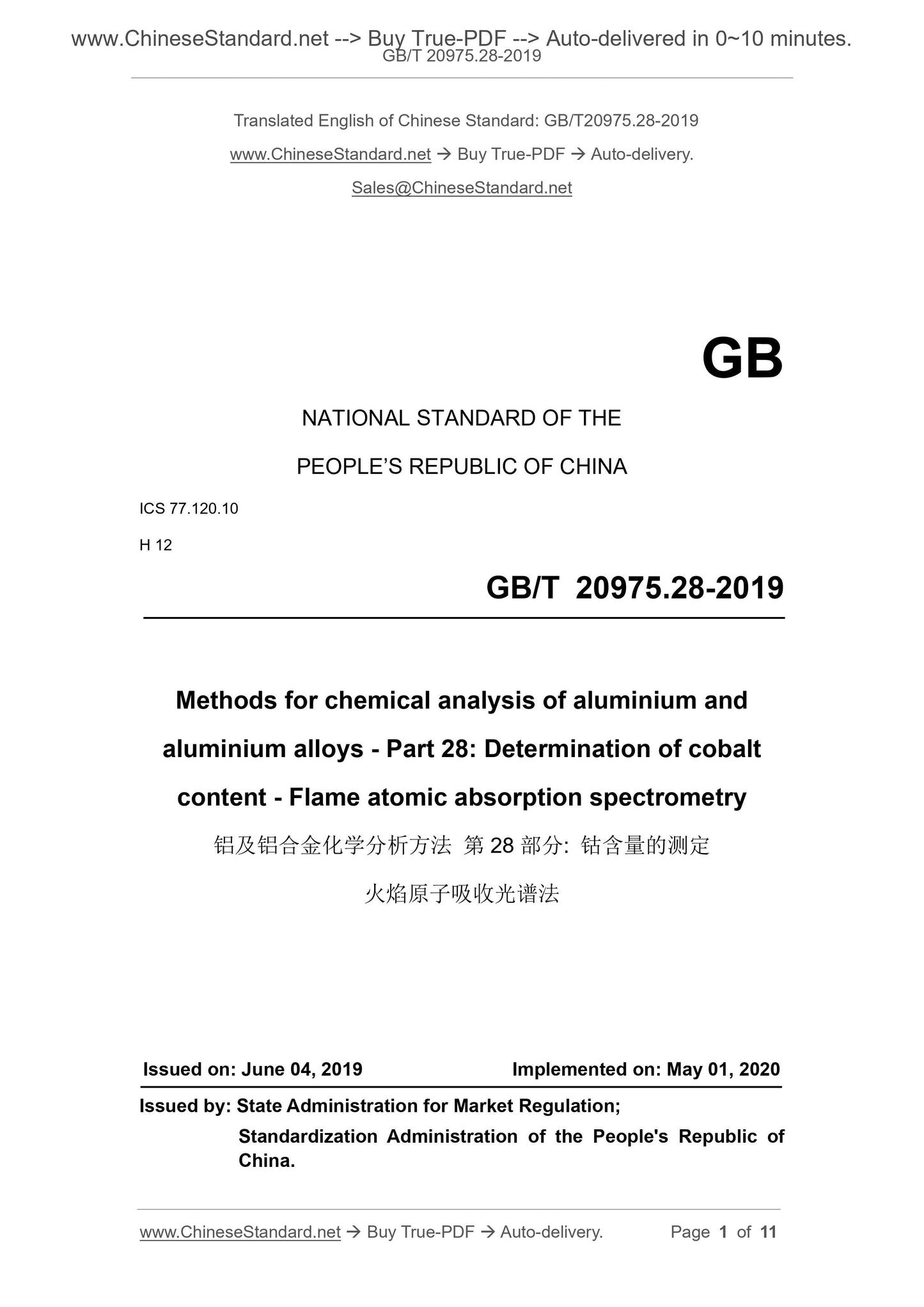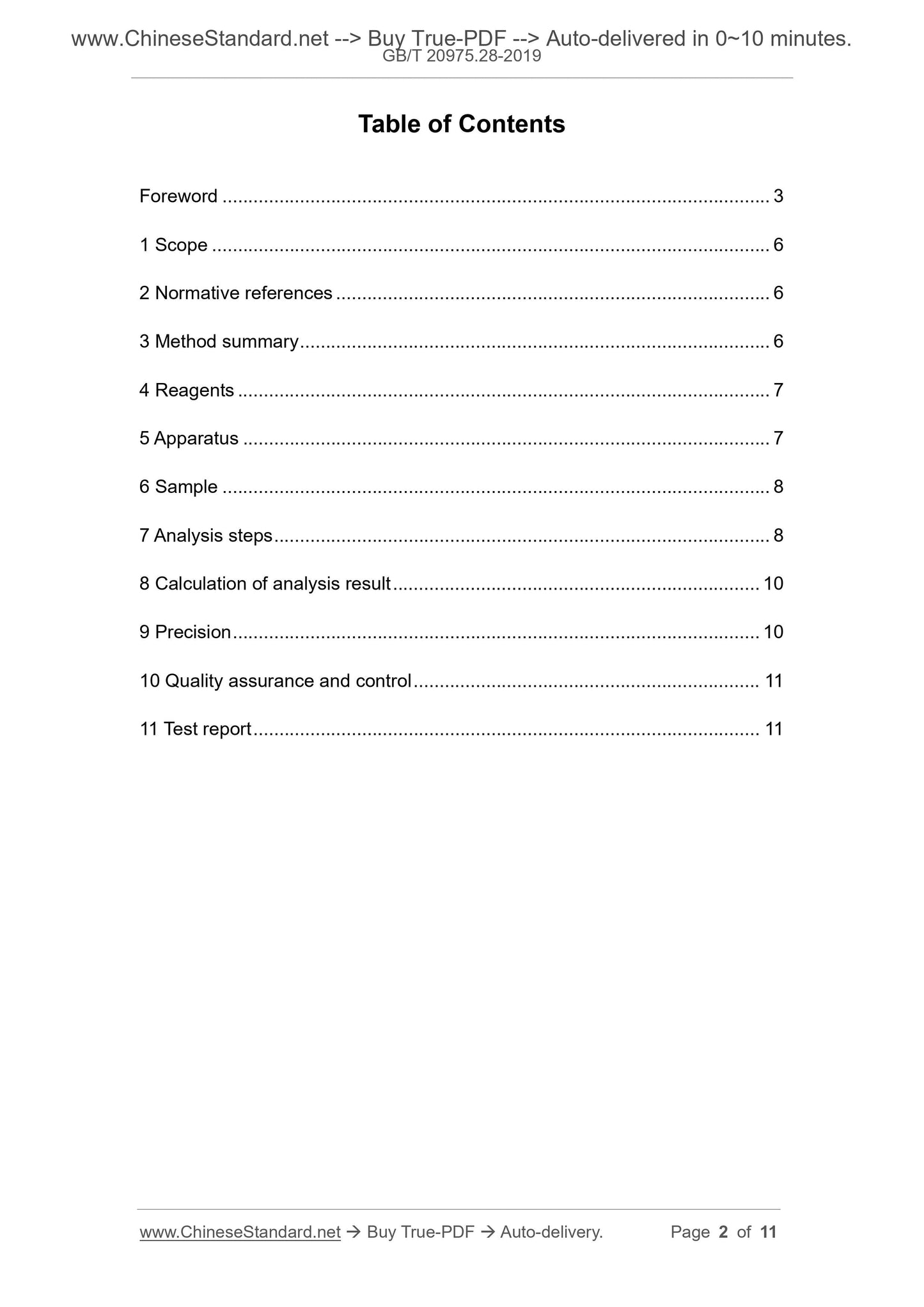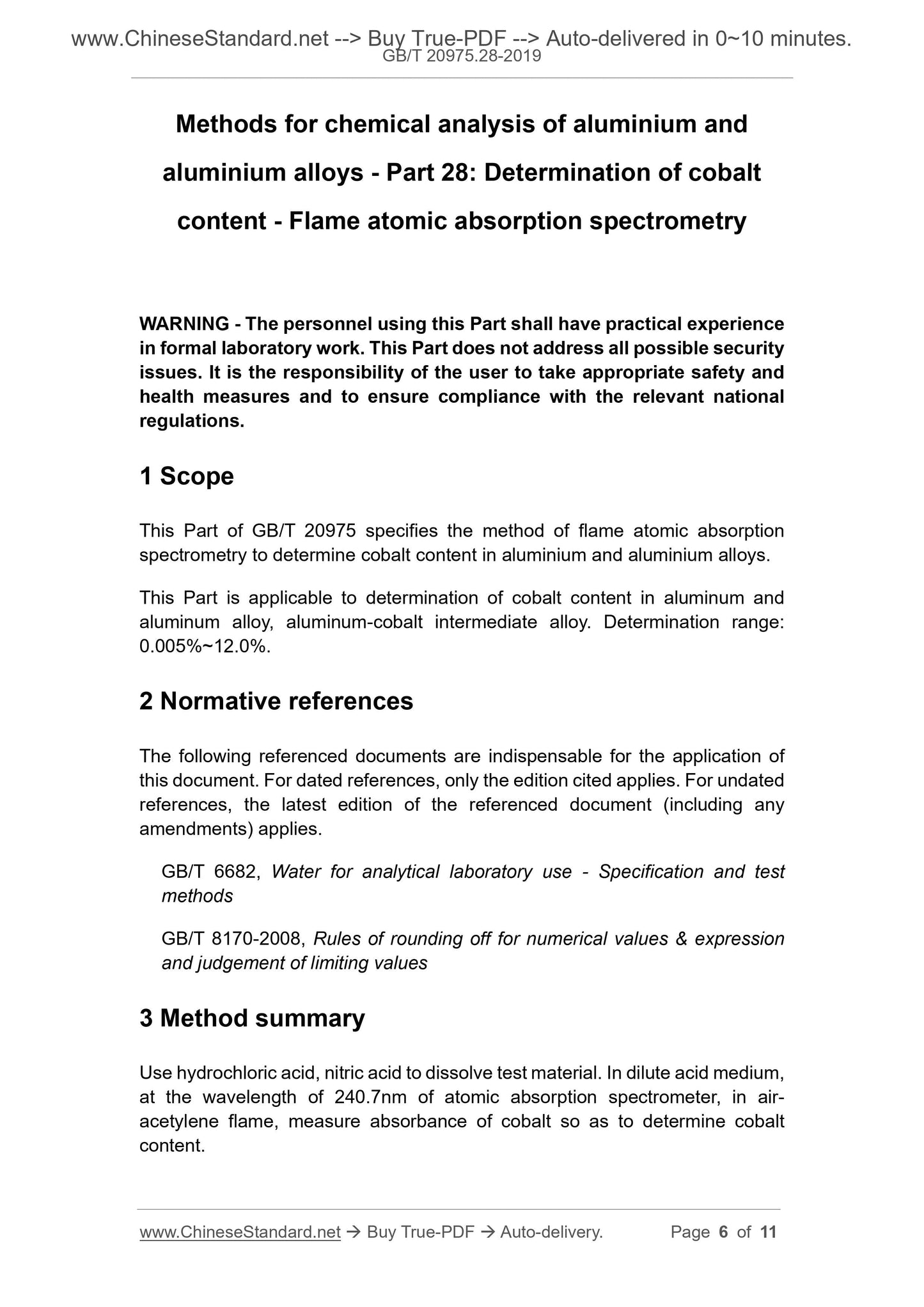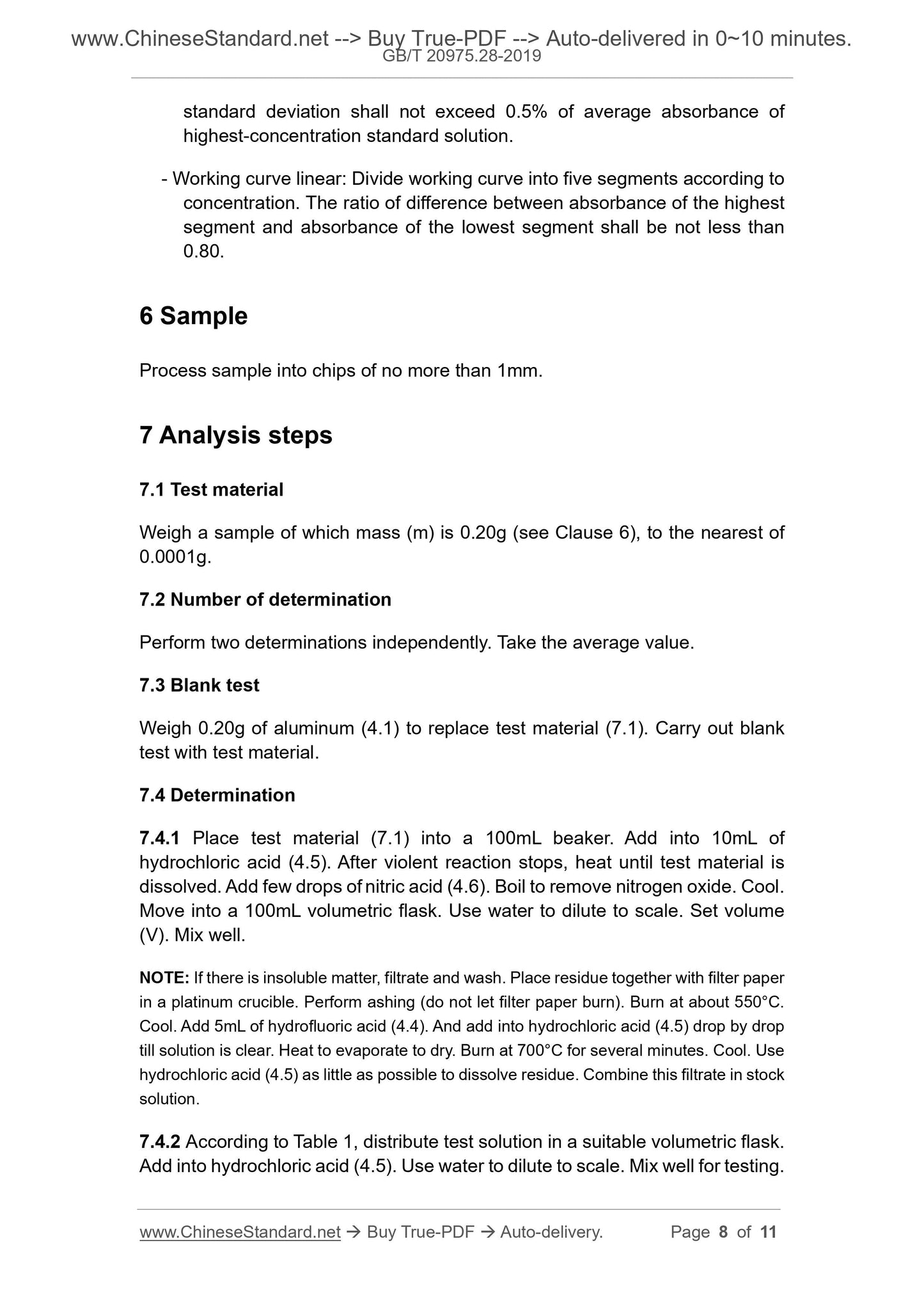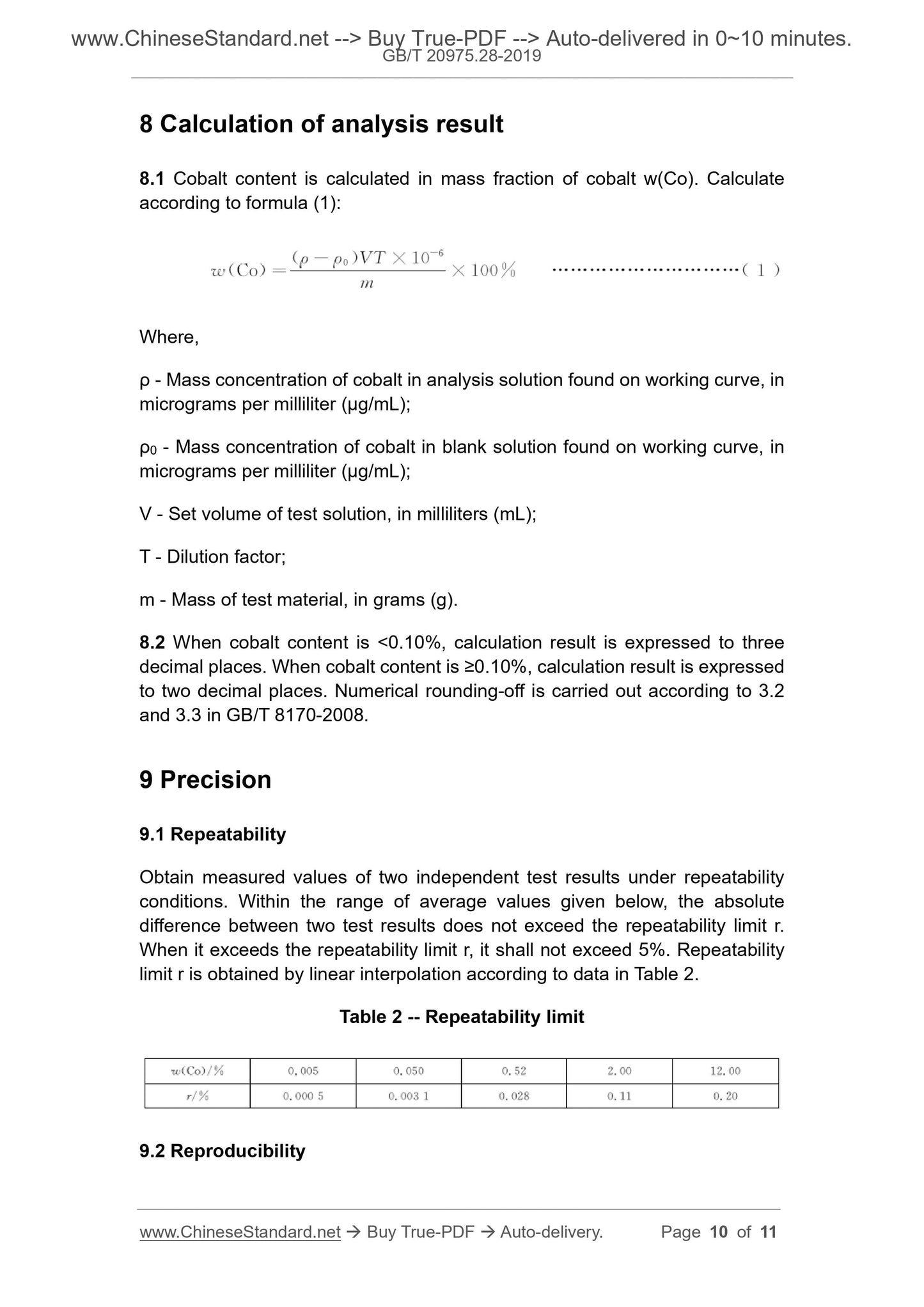1
/
of
5
PayPal, credit cards. Download editable-PDF & invoice In 1 second!
GB/T 20975.28-2019 English PDF (GB/T20975.28-2019)
GB/T 20975.28-2019 English PDF (GB/T20975.28-2019)
Regular price
$90.00 USD
Regular price
Sale price
$90.00 USD
Unit price
/
per
Shipping calculated at checkout.
Couldn't load pickup availability
Delivery: 3 seconds. Download true-PDF + Invoice.
Get QUOTATION in 1-minute: Click GB/T 20975.28-2019
Historical versions: GB/T 20975.28-2019
Preview True-PDF (Reload/Scroll if blank)
GB/T 20975.28-2019: Methods for chemical analysis of aluminium and aluminium alloys -- Part 28: Determination of cobalt content -- Flame atomic absorption spectrometry
GB/T 20975.28-2019
NATIONAL STANDARD OF THE
PEOPLE’S REPUBLIC OF CHINA
ICS 77.120.10
H 12
Methods for chemical analysis of aluminium and
aluminium alloys - Part 28: Determination of cobalt
content - Flame atomic absorption spectrometry
ISSUED ON: JUNE 04, 2019
IMPLEMENTED ON: MAY 01, 2020
Issued by: State Administration for Market Regulation;
Standardization Administration of the People's Republic of
China.
Table of Contents
Foreword ... 3
1 Scope ... 6
2 Normative references ... 6
3 Method summary ... 6
4 Reagents ... 7
5 Apparatus ... 7
6 Sample ... 8
7 Analysis steps ... 8
8 Calculation of analysis result ... 10
9 Precision ... 10
10 Quality assurance and control ... 11
11 Test report ... 11
Methods for chemical analysis of aluminium and
aluminium alloys - Part 28: Determination of cobalt
content - Flame atomic absorption spectrometry
WARNING - The personnel using this Part shall have practical experience
in formal laboratory work. This Part does not address all possible security
issues. It is the responsibility of the user to take appropriate safety and
health measures and to ensure compliance with the relevant national
regulations.
1 Scope
This Part of GB/T 20975 specifies the method of flame atomic absorption
spectrometry to determine cobalt content in aluminium and aluminium alloys.
This Part is applicable to determination of cobalt content in aluminum and
aluminum alloy, aluminum-cobalt intermediate alloy. Determination range:
0.005%~12.0%.
2 Normative references
The following referenced documents are indispensable for the application of
this document. For dated references, only the edition cited applies. For undated
references, the latest edition of the referenced document (including any
amendments) applies.
GB/T 6682, Water for analytical laboratory use - Specification and test
methods
GB/T 8170-2008, Rules of rounding off for numerical values and expression
and judgement of limiting values
3 Method summary
Use hydrochloric acid, nitric acid to dissolve test material. In dilute acid medium,
at the wavelength of 240.7nm of atomic absorption spectrometer, in air-
acetylene flame, measure absorbance of cobalt so as to determine cobalt
content.
standard deviation shall not exceed 0.5% of average absorbance of
highest-concentration standard solution.
- Working curve linear: Divide working curve into five segments according to
concentration. The ratio of difference between absorbance of the highest
segment and absorbance of the lowest segment shall be not less than
0.80.
6 Sample
Process sample into chips of no more than 1mm.
7 Analysis steps
7.1 Test material
Weigh a sample of which mass (m) is 0.20g (see Clause 6), to the nearest of
0.0001g.
7.2 Number of determination
Perform two determinations independently. Take the average value.
7.3 Blank test
Weigh 0.20g of aluminum (4.1) to replace test material (7.1). Carry out blank
test with test material.
7.4 Determination
7.4.1 Place test material (7.1) into a 100mL beaker. Add into 10mL of
hydrochloric acid (4.5). After violent reaction stops, heat until test material is
dissolved. Add few drops of nitric acid (4.6). Boil to remove nitrogen oxide. Cool.
Move into a 100mL volumetric flask. Use water to dilute to scale. Set volume
(V). Mix well.
NOTE: If there is insoluble matter, filtrate and wash. Place residue together with filter paper
in a platinum crucible. Perform ashing (do not let filter paper burn). Burn at about 550°C.
Cool. Add 5mL of hydrofluoric acid (4.4). And add into hydrochloric acid (4.5) drop by drop
till solution is clear. Heat to evaporate to dry. Burn at 700°C for several minutes. Cool. Use
hydrochloric acid (4.5) as little as possible to dissolve residue. Combine this filtrate in stock
solution.
7.4.2 According to Table 1, distribute test solution in a suitable volumetric flask.
Add into hydrochloric acid (4.5). Use water to dilute to scale. Mix well for testing.
8 Calculation of analysis result
8.1 Cobalt content is calculated in mass fraction of cobalt w(Co). Calculate
according to formula (1):
Where,
ρ - Mass concentration of cobalt in analysis solution found on working curve, in
micrograms per milliliter (μg/mL);
ρ0 - Mass concentration of cobalt in blank solution found on working curve, in
micrograms per milliliter (μg/mL);
V - Set volume of test solution, in milliliters (mL);
T - Dilution factor;
m - Mass of test material, in grams (g).
8.2 When cobalt content is < 0.10%, calculation result is expressed to three
decimal places. When cobalt content is ≥0.10%, calculation result is expressed
to two decimal places. Numerical rounding-off is carried out according to 3.2
and 3.3 in GB/T 8170-2008.
9 Precision
9.1 Repeatability
Obtain measured values of two independent test results under repeatability
conditions. Within the range of average values given below, the absolute
difference between two test results does not exceed the repeatability limit r.
When it exceeds the repeatability limit r, it shall not exceed 5%. Repeatability
limit r is obtained by linear interpolation according to data in Table 2.
Table 2 -- Repeatability limit
9.2 Reproducibility
Get QUOTATION in 1-minute: Click GB/T 20975.28-2019
Historical versions: GB/T 20975.28-2019
Preview True-PDF (Reload/Scroll if blank)
GB/T 20975.28-2019: Methods for chemical analysis of aluminium and aluminium alloys -- Part 28: Determination of cobalt content -- Flame atomic absorption spectrometry
GB/T 20975.28-2019
NATIONAL STANDARD OF THE
PEOPLE’S REPUBLIC OF CHINA
ICS 77.120.10
H 12
Methods for chemical analysis of aluminium and
aluminium alloys - Part 28: Determination of cobalt
content - Flame atomic absorption spectrometry
ISSUED ON: JUNE 04, 2019
IMPLEMENTED ON: MAY 01, 2020
Issued by: State Administration for Market Regulation;
Standardization Administration of the People's Republic of
China.
Table of Contents
Foreword ... 3
1 Scope ... 6
2 Normative references ... 6
3 Method summary ... 6
4 Reagents ... 7
5 Apparatus ... 7
6 Sample ... 8
7 Analysis steps ... 8
8 Calculation of analysis result ... 10
9 Precision ... 10
10 Quality assurance and control ... 11
11 Test report ... 11
Methods for chemical analysis of aluminium and
aluminium alloys - Part 28: Determination of cobalt
content - Flame atomic absorption spectrometry
WARNING - The personnel using this Part shall have practical experience
in formal laboratory work. This Part does not address all possible security
issues. It is the responsibility of the user to take appropriate safety and
health measures and to ensure compliance with the relevant national
regulations.
1 Scope
This Part of GB/T 20975 specifies the method of flame atomic absorption
spectrometry to determine cobalt content in aluminium and aluminium alloys.
This Part is applicable to determination of cobalt content in aluminum and
aluminum alloy, aluminum-cobalt intermediate alloy. Determination range:
0.005%~12.0%.
2 Normative references
The following referenced documents are indispensable for the application of
this document. For dated references, only the edition cited applies. For undated
references, the latest edition of the referenced document (including any
amendments) applies.
GB/T 6682, Water for analytical laboratory use - Specification and test
methods
GB/T 8170-2008, Rules of rounding off for numerical values and expression
and judgement of limiting values
3 Method summary
Use hydrochloric acid, nitric acid to dissolve test material. In dilute acid medium,
at the wavelength of 240.7nm of atomic absorption spectrometer, in air-
acetylene flame, measure absorbance of cobalt so as to determine cobalt
content.
standard deviation shall not exceed 0.5% of average absorbance of
highest-concentration standard solution.
- Working curve linear: Divide working curve into five segments according to
concentration. The ratio of difference between absorbance of the highest
segment and absorbance of the lowest segment shall be not less than
0.80.
6 Sample
Process sample into chips of no more than 1mm.
7 Analysis steps
7.1 Test material
Weigh a sample of which mass (m) is 0.20g (see Clause 6), to the nearest of
0.0001g.
7.2 Number of determination
Perform two determinations independently. Take the average value.
7.3 Blank test
Weigh 0.20g of aluminum (4.1) to replace test material (7.1). Carry out blank
test with test material.
7.4 Determination
7.4.1 Place test material (7.1) into a 100mL beaker. Add into 10mL of
hydrochloric acid (4.5). After violent reaction stops, heat until test material is
dissolved. Add few drops of nitric acid (4.6). Boil to remove nitrogen oxide. Cool.
Move into a 100mL volumetric flask. Use water to dilute to scale. Set volume
(V). Mix well.
NOTE: If there is insoluble matter, filtrate and wash. Place residue together with filter paper
in a platinum crucible. Perform ashing (do not let filter paper burn). Burn at about 550°C.
Cool. Add 5mL of hydrofluoric acid (4.4). And add into hydrochloric acid (4.5) drop by drop
till solution is clear. Heat to evaporate to dry. Burn at 700°C for several minutes. Cool. Use
hydrochloric acid (4.5) as little as possible to dissolve residue. Combine this filtrate in stock
solution.
7.4.2 According to Table 1, distribute test solution in a suitable volumetric flask.
Add into hydrochloric acid (4.5). Use water to dilute to scale. Mix well for testing.
8 Calculation of analysis result
8.1 Cobalt content is calculated in mass fraction of cobalt w(Co). Calculate
according to formula (1):
Where,
ρ - Mass concentration of cobalt in analysis solution found on working curve, in
micrograms per milliliter (μg/mL);
ρ0 - Mass concentration of cobalt in blank solution found on working curve, in
micrograms per milliliter (μg/mL);
V - Set volume of test solution, in milliliters (mL);
T - Dilution factor;
m - Mass of test material, in grams (g).
8.2 When cobalt content is < 0.10%, calculation result is expressed to three
decimal places. When cobalt content is ≥0.10%, calculation result is expressed
to two decimal places. Numerical rounding-off is carried out according to 3.2
and 3.3 in GB/T 8170-2008.
9 Precision
9.1 Repeatability
Obtain measured values of two independent test results under repeatability
conditions. Within the range of average values given below, the absolute
difference between two test results does not exceed the repeatability limit r.
When it exceeds the repeatability limit r, it shall not exceed 5%. Repeatability
limit r is obtained by linear interpolation according to data in Table 2.
Table 2 -- Repeatability limit
9.2 Reproducibility
Share
